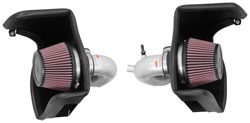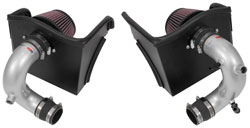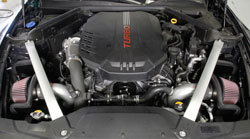
The 2018 Kia Stinger GT is the hottest car that Kia has ever made | The 2018 Kia Stinger GT is like going through an old family photo album, and finding a picture of your grandmother at Woodstock. She's a sweet old lady now. She goes to church, drives a Buick, dotes on the grandkids. But in her day, she liked to rock. Such a revelation would be quite surprising, and that's pretty much the reaction that Kia got when they unveiled their new tire-melting midsize sport sedan. It was unlike anything they'd ever made, and that alone made it great. Beneath the sexy 5-door coupe bodywork is a taut rear drive chassis that's pushed around by the direct-injected 3.3L GDI Twin-Turbo V6. Thanks to a cleverly efficient, low friction design, this boosted power plant can pour 365-hp & 376 lb-ft onto the rear, or all four wheels. Depending on the equipment, a 2018 Kia Stinger GT can accelerate to 60 mph in under five seconds. But if that's not enough for you, installing a K&N 69-5318TS Performance Intake System can add an estimated increase of 9.09 horsepower and 8.31 lb-ft of torque. Kia Stinger GT - How The Turbos Work 
The K&N 69-5318TS Typhoon Intake System for the Kia 3.3L twin-turbo | The Hyundai / Kia Lambda II 3.3L V6 utilizes exhaust manifolds that are cast directly into the cylinder heads. This means that each turbo can be fitted directly to the exhaust port on the head, which allows the turbos to spool much faster than if they were mounted further down the exhaust system. Then as air comes in through the stock airboxes, it can be pressurized by the air compressor and cooled by the intercooler. Doing so forces more oxygen molecules into the cylinders, so the Kia 3.3L twin-turbo can extract more energy and horsepower from the gasoline as it burns. However, airflow restrictions inside the OE Kia Stinger GT intake can actually reduce the amount of cold air reaching the motor. Which in turn, limits the performance.How a K&N 69-5318TS Typhoon Intake System Can Improve Performance 
Twin aluminum intake tubes have integrated fittings for the factory sensors | When you're trying to optimize airflow, you want to have a more direct path to the engine. That's why the stock plastic intake tube on both sides of the engine is replaced by much larger aluminum intake tubes, which feature mandrel bent curves to reduce turbulence as the air flows down into the turbo. these tubes also have fittings for all of the factory sensors, so you won't have to make any modifications during the installation. The tubes are connected to a self sealing heat shield that uses a special rubber gasket to help prevent warm engine air from entering the system. This is especially important because warm air contains fewer oxygen molecules than cold air, and that means you won't be able to make as much power with it. Behind the two heat shields sit a pair of oversized K&N performance air filters. They're positioned to pull in cold air from outside the engine compartment, and the large surface area means that more air will be pumped into the system, resulting in more power throughout the RPM range. This oxygen is cleaned by the famous K&N cotton gauze filter media, which has been treated with a proprietary oil blend. As air flows through the filter, the sticky cotton fibers trap and hold dirt particles that are smaller in diameter than a human hair. The dirt will then stay locked in the filter material for up to 100,000 miles before cleaning is required (depending on road conditions). With a higher volume of cold air to work with, your Kia Stinger GT will be able to make more torque at lower RPM, and more horsepower as the revs increase. The gas pedal will also respond much faster to your inputs, and the engine sound will be greatly improved. Dyno testing showed an estimated increase of 9.09 horsepower and 8.31 lb-ft of torque. But your individual results will depend on the mileage, modifications, and condition of your specific 2018 Kia Stinger GT. Improving the airflow and engine protection will dramatically improve the driving dynamics of your Kia hot rod. Add to that an unparalleled K&N 10-Year/Million Mile Limited Warranty, and the K&N 69-5318TS Air Intake System is a bolt on modification that actually makes sense. To find out if this K&N cold air intake is street legal in your state, click here. If your state doesn't have strict emissions laws, then you can click through to order. Or you can use the Search by Vehicle Tool to check out all of the Kia Stinger GT performance parts from K&N. Features & Benefits of the K&N 69-5318TS Typhoon Intake System - Designed for the 2018 Kia Stinger GT
- Guaranteed to increase horsepower
- Greatly improves airflow to the engine
- Sharpens throttle response
- Allows the Kia 3.3L twin-turbo to produce more low-RPM torque & high-RPM horsepower
- Improves engine sound
- Wide-diameter aluminum intake tubes have mandrel bent turns to reduce air turbulence
- High-flow K&N performance air filter can go up to 100,000 miles before cleaning is required (depending on driving conditions)
- Replaces the entire OE Kia Stinger GT air intake system
- No under-hood or ECU programming modifications required
- Installation takes around 90 minutes
- Covered by the K&N 10-Year/Million Mile Limited Warranty
2018 KIA STINGER 3.3L V6 Fuel Injection - Turbo

A K&N 69-5318TS Typhoon Intake System installed on a 2018 Kia Stinger GT | |














